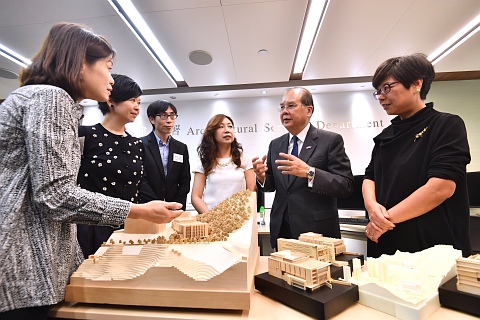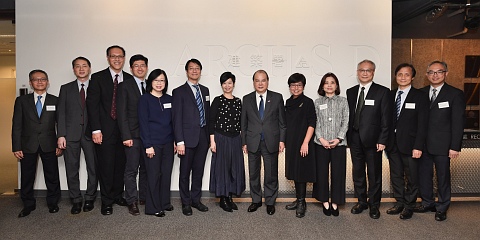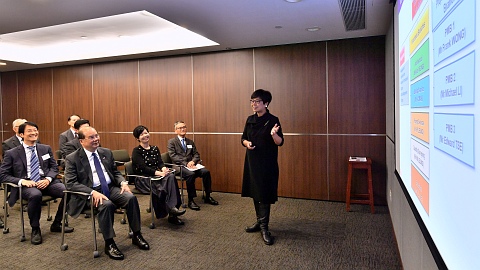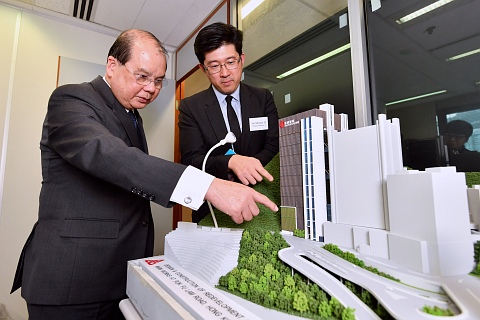Embracing new challenges with architectural innovation
21 April 2019
According to the Global Competitiveness Report 2018 published by the World Economic Forum, Hong Kong ranked second globally for competitiveness in infrastructure, showing that our infrastructure is world-class.
The construction industry in Hong Kong continues to thrive. It is projected that the level of overall construction expenditure will stay high, in the region of $250 billion to $300 billion per annum in the coming five years. The Government’s total capital investment in infrastructure in the next decade, which involves a number of large-scale projects closely related to people’s livelihood, including transportation, hospital and housing development projects, is estimated at over $1 trillion.
The local construction industry is facing the challenges of high construction cost, manpower shortage and declining productivity. To tackle these problems, the Government has strengthened manpower training for the industry to enhance the skills and competitiveness of construction workers on the one hand, and has encouraged the industry to proactively adopt innovation and technology (I&T) for the enhancement of productivity, cost-effectiveness and safety performance on the other. The application of I&T in all trades and industries is a sweeping trend, and the construction industry is no exception. The Government will assume the role of a pioneer by setting an example for the industry and taking the lead to move with the times.

|

|

|

|
Last week, I visited the Architectural Services Department (ArchSD) to get a better picture of the development of our public facilities, the priority projects in the pipeline, and how the department could further enhance the levels of quality and performance.
In terms of innovation, it is a breakthrough that the ArchSD has taken an active approach to using the Modular Integrated Construction (MiC). Many of us must have played with wooden building blocks. Putting together layers of prefabricated modules of building blocks, we can make a toy house. Construction methods in practice may also work in the same way.
MiC adopts the concept of “factory assembly followed by on-site installation”. Prefabricated free-standing integrated modules manufactured in a factory are delivered for on-site assembly. This method not only reduces the demand for on-site workers, but also ensures works quality and time control, minimises construction waste and enhances site safety.
We encourage the construction industry to embrace innovation in order to enhance productivity and cost-effectiveness. To this end, the ArchSD has adopted MiC in the construction of the Disciplined Services Quarters for the Fire Services Department in Pak Shing Kok, Tseung Kwan O on a pilot basis. It is expected that this public sector construction project will set an example for the industry for further promoting the use of the technology in the private sector or for other types of construction projects in the future.
Meanwhile, the Government has applied the technology of Building Information Modelling (BIM) in various construction projects to improve the design and co-ordination work, and to assist project teams in exercising professional judgement.
Resources are concentrated on the construction stage during the conventional construction process. The BIM work flow, however, requires proper co-ordination right from the design stage so that green construction can be achieved.
Take a public works project in Fu Shan, Sha Tin as an example. By applying BIM to enhance the structural design, concrete components were standardised and such components made up 40% of the standard floor area. Manpower required at the construction site was reduced and the effectiveness of precast components was maximised as a result. By using BIM to compare the amounts of soil needed to be excavated and backfilled under various design options, a more environmental-friendly design was chosen and 7 800 tonnes of construction waste, equivalent to the total load-carrying capacity of over 300 dump trucks, was reduced effectively. The labour force required, the pressure on landfills and the related carbon emissions were significantly reduced.
Apart from adopting BIM in major government capital works projects, the Government has also collaborated with the Construction Industry Council since 2018 to strengthen training for professionals. The use of such technology in private construction projects has been encouraged in a bid to drive architectural innovation in the construction industry through joint efforts.
The ArchSD will create a more convenient working environment and develop Hong Kong into a smart city by making better use of I&T concepts and technologies. Through the development of Corporate Intelligence, work flows will be digitalised and a big data bank with linkage to various application systems will be established to promote “architectural intelligence”.
As the Government plans to launch the electronic identity system next year, the industry may consider developing digital online platforms with such technology for the submission, approval, maintenance and retrieval of technical data and records in place of physical signatures and voluminous paper documents.
On cloud technology, BIM three-dimensional models and data are now available for use in smart mobile devices, and hence greatly enhance work mobility and productivity. Moreover, the industry may use artificial intelligence to analyse maintenance/repair data of property and facilities.
Technological advancement aside, this wave of architectural innovation also calls for nurturing of talent, which is even more important. Efforts should therefore be made to enhance the skills and functions of professionals, skilled workers and young people who aspire to join the industry to meet job requirements. As indicated in this year’s Budget, a provision of $200 million will be allocated to expand the apprenticeship scheme for the construction industry to cover more trades with manpower shortage, and the allowances for new trainees pursuing one-year full time programmes will be increased to encourage in-service workers to pursue continuing education.
To improve existing medical services and cope with an ageing population and growing demands for services, the Government introduced the first 10-year Hospital Development Plan (HDP) in 2016 to redevelop and expand 11 hospitals, and construct a new acute hospital, three Community Health Centres and one Supporting Services Centre. Among these, the construction works of quite a number of large-scale projects has already commenced. The 10-year HDP is one of the priority projects of the ArchSD.
In the second quarter of this year, the Government will seek funding approval from the Public Works Subcommittee of the Legislative Council for four works projects, namely the redevelopment of Kwai Chung Hospital, phases 2 and 3; demolition and foundation works for the redevelopment of Prince of Wales Hospital, phase 2 (stage 1); preparatory works for the expansion of North District Hospital; and preparatory works for the expansion of Lai King Building in Princess Margaret Hospital.
These projects of various scales have a significant bearing on people’s livelihood and the future of Hong Kong. I earnestly hope that the upcoming public works projects, and the relevant funding applications and proposals, will be taken forward smoothly with wide support from all sectors of the community.

